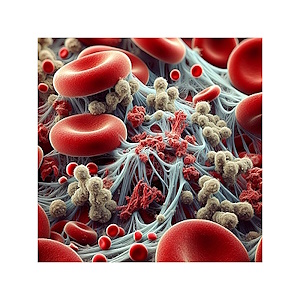Bedtime Efforts : Organic Summary II
Clifford E Carnicom
Feb 02 2024
The following does not qualify as bedtime reading, but an attempt will be made to provide a few bedtime paragraphs. The synthesis of this information requires a couple of seasons of work and some midnight oil along the way.
This paper represents a second generation summary of the organic (i.e., biological) nature of the Cross Domain Bacteria (CDB (nomenclature origin here) under study for more than two decades by Carnicom Institute (CI). Although developed further, the work remains at at a primitive level relative to that required, necessary and possible under the proper conditions. The research record for context is available here.
The reason for this type of work is that it provides the minimum required information to develop internal evidence based strategies for mitigation, interference or termination of the CDB health impacts. This impact includes blood clotting, damage and destruction. The CDB and the synthetic biology that envelops it is no less than an assault on and threat to human existence. This claim will not be discussed further here, as it been made in repetition previously.
The issues of increased blood clotting and the severe threats it presents, including the inadequately defined associations of the Covid Era, are the primary reason for the recent resurgence in CI research. Certain stages of accomplishment are being sought and realized within the means, time and resources available. This paper represents a significant stage of that planning. Opportunity has existed for decades, but it does not exist indefinitely. CI will continue to serve within its means and the context of that planning.
The work offers a more thorough study of four different metabolic products from CDB culture. From this point on, the paper will focus on the specific results of analysis and the bedtime story is already likely beginning to wane…
________________________________________________________
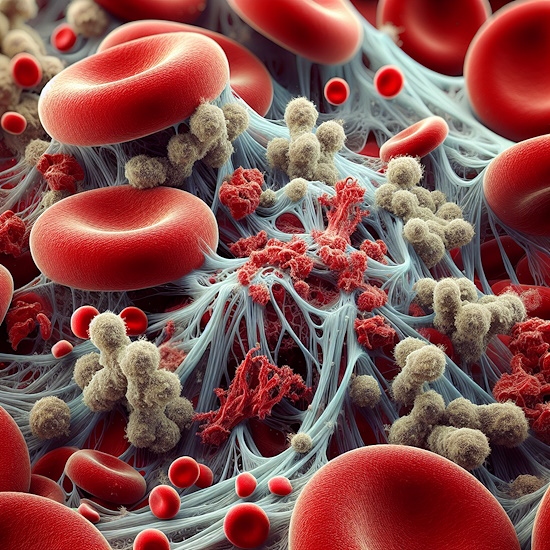
Conceptual Image of Organic Summary II Components
Microscope Images of Record Available on CI Site
There are a minimum of five generations of cultures developed over the last two decades. The cultures share common themes and constituents, but differences also exist depending upon the particular mediums chosen. In total, the cultures are responsible for developing at least a couple dozen variations in metabolic products, with various proteins, polymers, lipids and DNA realized within that chronicle of research. The existence of the CDB as the origin of all forms and the conclusion of synthetic biology is a central tenet and conclusion of this work.
The current culture work is well representative of the various generations, and demonstrates biological (additionally, synthetic) sophistication that would keep thoughtful researchers occupied for decades. No such luxury exists at this point, so we are left scrapping for the essentials with relatively limited tools. So be it; the fire still burns.
Four variations in form will be discussed here. For simplicity, they will be itemized as follows:
1. Middle layer
2. Top layer
3. Bottom Layer
4. Mid infrared analysis of a 2015 CDB culture sample
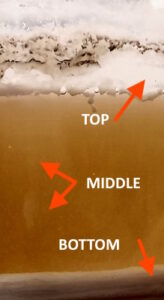
CDB Culture Layers Under Analysis
(front view)
The culture as shown takes approximately 1-2 months to develop.
I will start with the middle layer, as it is responsible for the creation of the top and bottom layers as well. This is a water soluble development, and it comprises the bulk of the mass as shown above. The consequences of water solubility as it affects distribution throughout the human body has been discussed in previous papers. I will confine the current discussion to listing the functional groups, biomolecules, etc., that have been identified. The importance of this and subsequent listings is stated above.
________________________________________________________
Representative methods of analysis include:
1. Reflectance spectrometry
2. Visible light spectrometry
3. Near Infrared (NIR) spectrometry.
4. Liquid column chromatography
5. Titration (multiple equivalence points exist within the middle layer)
6. Qualitative organic chemistry analyses
7. Inorganic qualitative analyses
8. Microscopy
9. Conductivity tests
10. Water test kit analysis
11. Forensic & digital meter hemoglobin testing
12. Protein detection reagent development
13. Mid infrared (for the 2015 culture spectrum)
14. Spectroscopy Reference Sources, IR databases, IR software analysis
15. Professional mid infrared analysis (comparative) (for the 2015 culture spectrum)
16. AI engine chemometric and spectroscopic inquiry/cross-examination analyses
17. Statistical testing methods
The listings are subject to revision, but they represent the most probable assessment of component analysis at this time.
___________________________________
A. OVERVIEW OF MOST PROBABLE MIDDLE LAYER CONSTITUENTS
(dominated by water solubility)
1. Protein(s)
2. Aromatics (subject to polymerization)
3. Phenols
4. Amines
5. Aromatic amino acids likely, specifically tyrosine and tryptophan.
6. Vinyl functional groups
7. Alkenes (reactive chemical bond) (subject to polymerization)
8. Polyenes
9. Methylene group
10. Methyl group
11. Alkyl alcohol
12. Hydroxyl group
13. High electrical conductivity (inorganics, ion presence)
14. Moderate to strong acidity
15. Solubility qualitative organic. tests w/pH indicate low molecular weight carboxylic acids are present.
16. Known to be able to produce a calcium carbonate polymer within a specific chemical environment.
17. Evidence for the existence of a filamentous bacteriophage does exist, and it remains under evaluation.
___________________________________
The risk to health certainly increases with the development of the top layer, which is of polymer form.
B. OVERVIEW OF MOST PROBABLE TOP LAYER CONSTITUENTS
(dominated by polymerization and synthetic blood development)
1. Alkyl alcohol
2. Amides,
3. Amines
4. Protein
3. Nucleic acids/DNA in the top layer.
5. Polymer(s) .
6. Synthetic blood production.
7. Hemoglobin
8. Aromatic CH
9. Polyamides
10. Polycyclic aromatics
11. Aromatics with extended rings
12. Polymer micro-spheres (~0.25 microns) (evidence of association with synthetic blood production) (discussion below)
13. Phenols
14. Carboxylic acids
Additional discussion of the top polymer layer is helpful. This layer will form from a uniform water soluble medium and has the appearance shown below. It displays all behaviors characteristic of a polymer. It is uniform, white in color, insoluble in water and behaves as a very soft plastic material is expected to.
Microscopic examination of the top polymer layer reveals a previously unseen internal structure. It is, at least in part, composed of small, densely packed, uniform spheres that are not characteristic of the larger CDB. The general impression is that of uniform micro-spheres that measure approx. 0.25 microns (um). This is the smallest size of metabolic products from a CDB culture that have been observed or measured to date. It is fair to consider it at the limit of what is observable with visible light microscopy. The CDB measure approx. 0.5 um optically but resolution is a limiting factor. Provided electron microscopy has shown the most resolved images of the CDB to be at ~0.3 um in diameter. Due to the optical resolution issues, it will not be surprising if the micro-spheres below measure eventually at less than 0.25 um in diameter.
This remains outside the range of nanotechnology, essentially by the limitations of visible microscopy. It does, however, approach that boundary by an order of magnitude or two. It remains inappropriate, as it always has, to classify materials as nanotechnology that are not observable or measurable as such. Molecular knowledge, such as spectroscopic functional analysis, is an entirely different matter as it is operative beneath the nano-material level. Physical behavior or properties of materials may also be confirmatory of nanotechnology. All images shown here, however, remain at the micro level and it remains essential to keep such size distinctions clear.
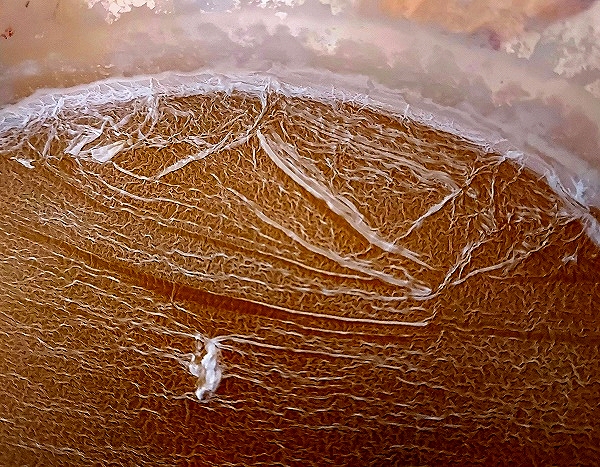
Top Layer – Polymer Formation (macro view)
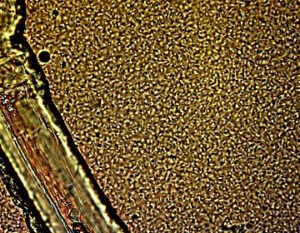
Top Layer Polymer at 3200x.
Uniform micro-spheres (measurement approximately 0.25 microns)
characteristic of polymer formation are visible in majority of image.
CDB developed filament layer to left.
Continuing at a higher magnification:
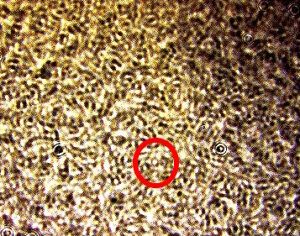
Initial Stage Top Layer Polymer at 8000x.
Uniform microspheres (measurement ~0.25 microns)
Uniformity and density is characteristic of polymer formation
The photograph below presents some intriguing observations. It appears to be the same material as immediately above but at a later date of culture growth. There are two important distinctions to note. First, the size of the objects have increased in size in this case to ~1.5 um in diameter. Secondly, the geometry of the objects is assuming concavity or bi-concavity. The resemblance to erythrocyte geometry can not be dismissed or ignored here. Knowing that this polymer layer has previously been confirmed to produce synthetic blood and hemoglobin, it is not any stretch to postulate that the micro-spheres shown above may well be involved in the development of the synthetic blood. It is also worthy to mention that at various stages of observation of the synthetic blood that cells of ~4 um diameter (vs 6-8 um characteristic of human blood) are commonly observed. Circular and bi-concavity remains characteristic at all times, however, and hemoglobin presence has been confirmed from previous testing.
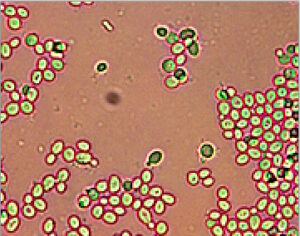
Top layer development at a later date at 3200x.
Spheres/disks increase in size (~1.5 um) and assume concave geometry.
___________________________________
C. OVERVIEW OF MOST PROBABLE BOTTOM LAYER CONSTITUENTS
The bottom layer has not been studied at the level of detail as the previous middle and top layers. NIR overview analysis, however, indicates that it shares many of the same organic properties as the top layer. The main observable difference at this point is that the layer sinks. The conclusion from this is that the bottom layer is more dense than the top layer, regardless of similarities that exist between the two. This in turn implies that the the bottom layer may have a higher inorganic content, such as metals, than the top layer.
It is therefore appropriate to mention that significant related inorganic analysis has previously taken place within CDB polymers or growth, and two sources are as follows:
1. Environmental Filament, Project: Metals Testing Laboratory Report (Aug 2017)
This paper describes the results of a high level analytical examination (ICMP-MS) of the “Environmental Filament” that has been extensively studied within CI. Numerical results are available at the paper mentioned. The summary report lists the following inorganics (metals) found:
Aluminum
Barium
Calcium
Chromium
Copper
Iron
Lead
Magnesium
Manganese
Nickel
Potassium
Titanium
Vanadium
Zinc
2. Blood Alterations : A Six Part Series (Aug 2022 – Oct 2022)
In addition, another CI project (six research papers) that studies the CDB transformation of human blood with the application of electrical current lists the following inorganics presents, along with expected impacts to human health from their presence:
Blood Subjected to Electrical Current:
Foam Precipitate Candidate Chemical Constituents:
1. Halogens (Cl, Fl, Br, I)
2. Peroxide (H202,oxidizer)
3. Hydrazoic Acid (HN3)
4. Electrolytes (Na, Ca, Mg, etc.)
5. Metals in ionic form (Fe, Al, Mn)
6. Nitrogen & Sulfur compounds
____________
Blood Subjected to Electrical Current:
Settled Layer Candidate Chemical Constituents:
1. Halogens (Cl, Br)
2. Peroxide (H202,oxidizer)
3. Phosphate compound (H3PO4)
4. Metals in ionic form (Ca, Fe, Mg, Al)
5. Hydrazoic Acid (HN3)
6. Iron – cyanide complex [Fe(CN6)]
7. Metals in ionic form (Fe, Al, Mn)
8. Nitrogen & Sulfur compounds
The extensive list of inorganic compounds or elements equally justifies the rationale for this summary report.
___________________________________
C. OVERVIEW OF MOST PROBABLE CONSTITUENTS OF MID INFRARED 2015 CULTURE SAMPLE:
The last sample is to be treated and discussed separately, as it has unique aspects to it. In the middle of the previous decade, CI had access to a mid infrared instrument of high quality. Mid infrared technology operates at a level of molecular detail that is much higher than that of near infrared (NIR). Access to mid infrared is highly valued, and it is hoped that this can be restored within CI capabilities.
Extensive mid infrared work accomplished by CI during that decade remains vastly under utilized to this day. Approximately 1000 spectra were acquired at the time, and they are all available within the CI Library Download Portal. The objective at the time was primarily to collect data as its value was recognized. Interpretation of mid infrared is an entirely different prospect and profession, and this was conducted as time permitted. This library remains of much value within our current plight of changing standards and loss of reference frames. What is defined as a reference for environmental, biological and health study has become a moving target since the year 2000.
As an example, numerous spectra were collected on human blood samples in the middle of the last decade (cerca 2015). This spectral database, given proper study, may offer additional insight into the impact of the “Covid Era” upon human blood if current samples will be compared.
The following is an example of a mid infrared spectrum collected in September 2015 of a CDB culture product now under discussion:
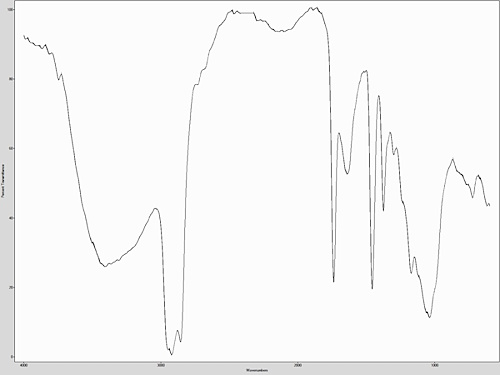
Mid infrared spectrum of CDB culture product collected in September 2015.
This spectrum was recently evaluated in greater detail than at the time of collection. One benefit of this is to offer comparison over a decade of time elapsed on particular sample types. In this case, the nature of the sample is that of a polymer form that was extensively cultured and studied at that time.
With sufficient study, (and it does take study), it is possible to construct at least a skeleton chemical model from a mid infrared spectrum. This has been done. Near infrared is usually of a more general nature, and is even more difficult to refine to any chemical model.
The objective of the modeling process here is to combine the probable functional groups in the minimum structure possible. The purpose is to assess the general properties of the compound as well as reactivity that might be expected from it. There is absolutely no extrapolation of this model to incorporate polymeric activity; it is intentionally minimalist in nature. This effort can be viewed as an ongoing project depending upon any access to mid infrared capability again in the future. Current biological samples will now be required (e.g., blood, Covid Era influence, reference, etc.), to bring matters up to date as well as for comparisons.
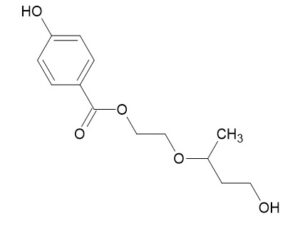
Skeletal functional group model of CBD metabolic product
from Sep 2015 culture study
________________________________________________________
The purpose of this paper is simply to present the status of chemical signature inquiry. There can be infinite discussion and further research that can ensue from the listings above alone. In the interest of brevity, which I have not achieved as usual, that discussion must be reserved for further chapters.
It is sincerely hoped that this information will be accepted as a seed for those discussions in the future by all. It is CI’s perspective that this type of information, unfortunately primitive as it may be, will provide some basis for mitigation, interference, or terminal strategies of CDB damage to health and the threat to our species.
Clifford E Carnicom
Feb 02 2024
Born Clifford Bruce Stewart, Jan 19 1953.

